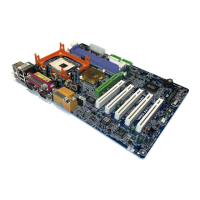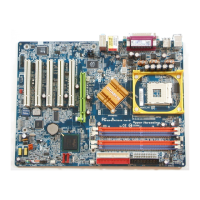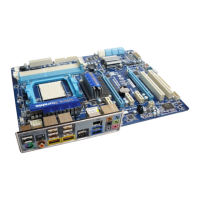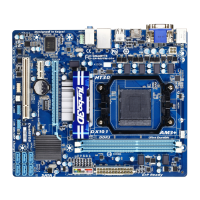Do you have a question about the Gigabyte GA-870A-UD3 and is the answer not in the manual?
Guidelines for safe installation of motherboard components and precautions against ESD.
Detailed technical specifications of the motherboard, including CPU, memory, storage, and expansion slots.
Step-by-step guide for installing the CPU and its associated cooler onto the motherboard.
Instructions for installing DDR3 memory modules, including dual-channel configuration.
Procedures for installing expansion cards into PCI Express or PCI slots.
Explanation of rear panel connectors such as USB, audio, LAN, and video ports.
Identification and description of various internal headers and connectors on the motherboard.
Describes the screens that appear during system boot-up, including POST and Logo screens.
Overview of the BIOS Setup main menu, navigation, and function keys.
Settings for CPU overclocking, clock ratios, voltages, and memory timing adjustments.
Configuration of system date, time, and IDE/SATA device parameters.
Settings for boot order, virtualization, CPU core control, and power management.
Configuration of onboard devices like SATA controllers, LAN, and USB ports.
Settings related to system power states, wake-up events, and power button behavior.
Monitoring of system temperatures, voltages, fan speeds, and status of case intrusion detection.
Option to load the safest BIOS default settings for system stability.
Option to load the factory default settings for optimal system performance.
Setting or disabling BIOS access passwords for security.
Saving BIOS configuration changes and exiting the setup utility.
Exiting BIOS setup without saving any modifications made during the session.
Guide to installing essential chipset drivers from the motherboard driver disk using Xpress Install.
List and installation of GIGABYTE utilities and other software provided on the driver disk.
Access to GIGABYTE's application guides and motherboard manuals from the driver disk.
Information on how to contact GIGABYTE support and offices worldwide.
Displays basic system information related to the motherboard and BIOS.
Links to GIGABYTE's website for downloading the latest BIOS, drivers, and applications.
Quick access to recently developed GIGABYTE utilities for installation.
Utility for quick system data backup and restoration, supporting NTFS, FAT32, FAT16 file systems.
Information on GIGABYTE's Q-Flash and @BIOS tools for updating the system BIOS.
Windows-based utility for fine-tuning system settings, overclocking, and monitoring hardware.
Technology for delivering power savings and enhancing efficiency without sacrificing performance.
A tool for easy and convenient data sharing among computers on the same network.
Feature for quickly creating backups of changed data files or copying files from a backup.
Tool to enable system power savings via a Bluetooth cell phone acting as a portable key.
Step-by-step guide for installing and configuring SATA hard drives, including RAID and AHCI modes.
Specific configuration steps for GIGABYTE SATA2 and JMicron JMB362 SATA controllers.
Instructions for creating a floppy disk with SATA RAID/AHCI drivers for OS installation.
Guide to installing SATA RAID/AHCI drivers and the operating system (Windows XP/Vista).
Procedures for restoring data to a hard drive by rebuilding a fault-tolerant RAID array.
Setup guide for configuring the motherboard's multi-channel audio output and input jacks.
Instructions for connecting and configuring digital audio input and output using S/PDIF connections.
Guide to enabling Dolby Home Theater for enhanced surround sound audio effects.
Steps for setting up and configuring the microphone input for recording sound.
Instructions on how to use the Sound Recorder utility to record and play audio.
Common questions and answers regarding BIOS settings, hardware issues, and driver installation.
A flowchart-based guide to diagnose and solve common system startup problems.
| Memory voltage | 1.5 V |
|---|---|
| Memory channels | Dual-channel |
| Number of memory slots | 4 |
| Supported memory types | DDR3-SDRAM |
| Maximum internal memory | 16 GB |
| Supported memory clock speeds | 1066, 1333, 1866 MHz |
| Supported memory module capacities | 4GB |
| System bus rate | 5.2 GT/s |
| Processor socket | Socket AM3 |
| Processor manufacturer | AMD |
| Compatible processor series | AMD Phenom II X2, AMD Phenom II X4, AMD Phenom II X6 |
| USB 2.0 connectors | 2 |
| Power fan connector | Yes |
| Number of SATA III connectors | 6 |
| BIOS type | AWARD |
| ACPI version | 1.0b |
| BIOS memory size | 16 Mbit |
| USB 2.0 ports quantity | 8 |
| VGA (D-Sub) ports quantity | 0 |
| Audio chip | Realtek ALC892 |
| Component for | PC |
| Motherboard chipset | AMD 870 (RX881) |
| Audio output channels | 7.1 channels |
| Motherboard form factor | ATX |
| Motherboard southbridge | AMD SB850 |
| Compatible operating systems | Windows 7/ Vista/ XP |
| RAID levels | 0, 1, 5, 10, JBOD |
| Supported storage drive interfaces | SATA |
| On-board graphics card | - |
| Parallel processing technology support | Not supported |
| PCI slots | 3 |
| Ethernet interface type | Gigabit Ethernet |
| Depth | 230 mm |
|---|---|
| Width | 305 mm |











